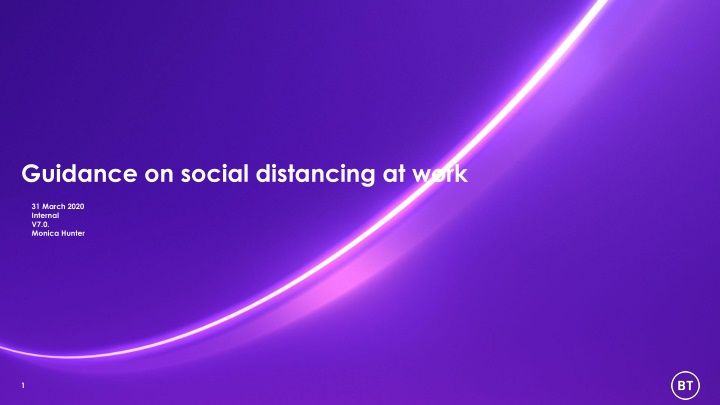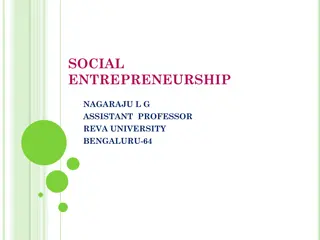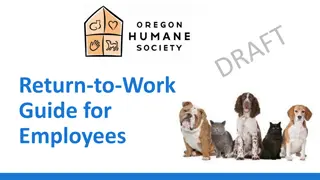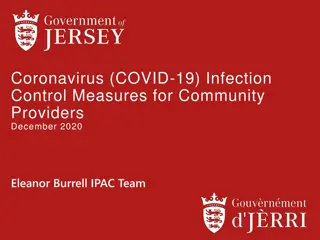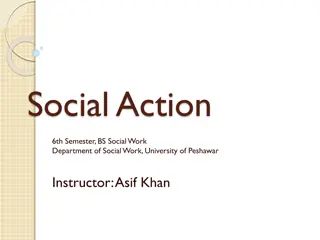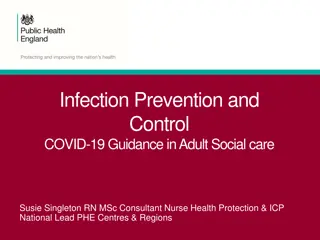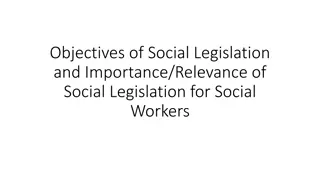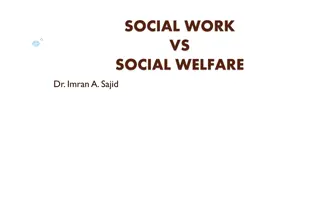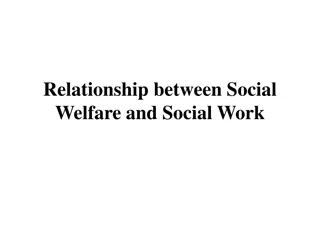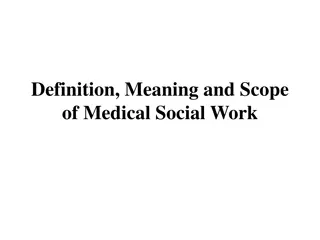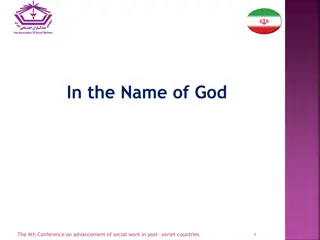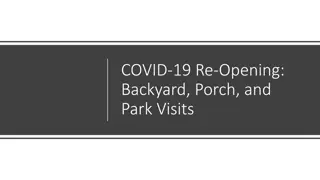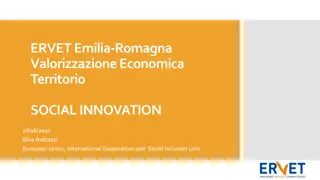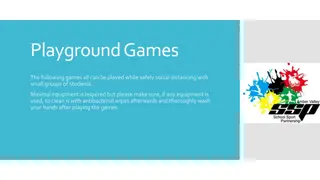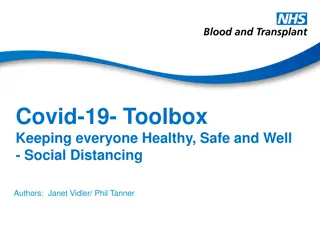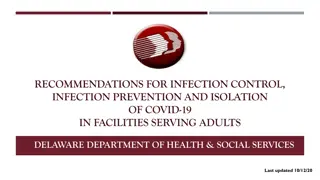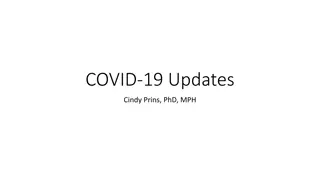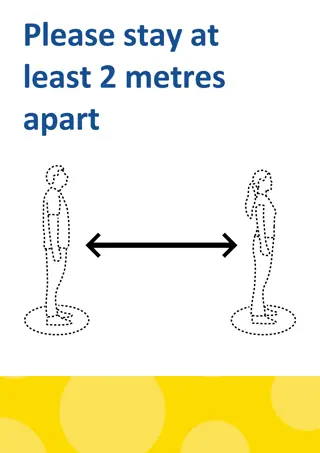Guidance on social distancing at work
The Government's policy of social distancing to prevent the spread of Covid-19 impacts key-workers who cannot work from home. New guidelines focus on colleague distancing, facility usage, hand hygiene, and environmental adaptations to ensure workplace safety. Measures include maintaining a 2m distance, frequent handwashing, utilization of open areas, and managing shared facilities. The guidance emphasizes the importance of adapting workspaces to prioritize health and safety while ensuring essential operations continue smoothly.
Download Presentation

Please find below an Image/Link to download the presentation.
The content on the website is provided AS IS for your information and personal use only. It may not be sold, licensed, or shared on other websites without obtaining consent from the author.If you encounter any issues during the download, it is possible that the publisher has removed the file from their server.
You are allowed to download the files provided on this website for personal or commercial use, subject to the condition that they are used lawfully. All files are the property of their respective owners.
The content on the website is provided AS IS for your information and personal use only. It may not be sold, licensed, or shared on other websites without obtaining consent from the author.
E N D
Presentation Transcript
Guidance on social distancing at work 31 March 2020 Internal V7.0. Monica Hunter 1
Overview The Government has introduced a nationwide policy of social distancing, which is critical to preventing the spread of Covid-19 Whilst many colleagues will work from home, we have key-workers critical to keeping our systems and infrastructure running, who cannot work from home. We need adopt new ways of working across sites for their health and safety We are issuing new guidance applicable to all sites but we recognise each site may have different opportunities and challenges; we ask that you work with the guidance and flag any challenges Anyone who is self isolation (either due to having symptoms or as a result of being a household contact) must not come to or be admitted into the workplace under any circumstances. If anyone develops any symptoms whilst at work, they are to immediately leave, following the guidance on Your Wellbeing. Specific cleaning requests should be made following the agreed PFS, ISS , CBRE process as per the process outlined on Your Wellbeing 2 Security classification. Published version. Owner's name. 2/22/2025 10:50 PM
Guidelines for social distancing in the workplace 1. Colleague distancing Each individual must have a minimum of 2m distance from each other within their area of work & rest areas (i.e. they need to be sat 2m away from their colleagues in all directions) To achieve this, we recommend that consideration is given to the following: Colleagues must be seated at alternate desks (one desk apart/2 m) Work areas are wiped down by colleagues when leaving and arriving If space is at a premium, critical staff have priority over desks. If needed, use existing desks, meeting rooms and spaces that are normally used by other teams. This may be on different floors, so think innovatively about how you can achieve this. Avoid face to face seating if possible, or introduce staggered seating Clean shared equipment (telephones/keyboards) between shifts; do not share headsets Leave non-fire rated/security internal doors open to avoid unnecessary touching of handles etc Ask colleagues to use existing pedestrian zones/walkways and consider barriers to limit shortcuts into areas ensure fire exits etc. not blocked. 3
Guidelines for social distancing in the workplace 2. Reduce risk across facilities Think carefully about how you use facilities to minimise risk: Colleagues must wash their hands on entering the building and every 2 hours thereafter with soap and water Consider schedule/timetable of usage of common relaxation areas Consider traffic flow to the toilets and limit number of people using at any one time to minimise contact in closed spaces. Ask colleagues to wait outside the toilet area to achieve this. Use the stairs where possible. Maintain distance if using the lifts and use a pen or similar to press the call buttons. Wash hands after leaving the lift. Relaxation areas will also need to be spaced out and colleagues must be reminded to maintain social distancing when using these areas. Weather permitting, use open areas around the building if new common relaxation areas are needed. Where possible open windows to increase ventilation in the room, work area, building. Where possible provide additional facilities to prevent congregation around kettles/microwaves etc. Where sources of instant hot water exist, use these instead of kettles and microwaves. If not create exclusion zone one at a time usage- with markers 2m apart. Remind smokers to social distance in smoking areas 4
Guidelines for social distancing in the workplace 3. Restaurants & food areas Most restaurant and canteens are now closed in our buildings but, if food is provided, colleagues are reminded to take away the food and not congregate in the restaurant areas. Disposable cutlery should be introduced- recyclable if possible. Encourage personal hygiene and if possible introduce hand gel stations on entry Avoid queues to use microwave for heating food- or provide wipes for cleaning after each person and enforce 2 m waiting distance Minimise congregating and enforce distancing (e.g. 1 person to a table) Enforce distancing in queues and consider spreading meal times out to minimise queuing Where payment is required, colleagues should use contactless, with no cash being handled 5
Guidelines for social distancing in the workplace 4. Emergency response During an emergency evacuation it may not be possible to maintain a 2m separation distance, but once safely out of the building social distancing guidelines must be enforced. First aid if no first aiders available, contact 999 for emergencies (serious injuries/illness). Area Facilities Managers (AFM) will provide basic first aid equipment for self-administration in minor injuries. In the case of minor illness, advise colleagues to contact their GP and go home if unable to continue to work safely Fire wardens if you do not have sufficient fire wardens, liaise with AFM. Online courses are available to train additional colleagues. Building Incident Controllers Where there is no BIC in place, business site lead will assume this role. AFM will provide information packs to support them in undertaking this role. 6
Practising hygiene measures Avoid non-essential use of public transport, vary travel times to avoid rush hour, when possible. Look to maintain social distancing when travelling. Encourage colleagues to walk where their journeys are of reasonable length. Wash your hands on arrival and often, using soap and water for at least 20 seconds or use hand sanitiser Frequently clean and disinfect objects and surfaces that are touched regularly Keep your hands away from your face Cough and sneeze into tissues or the crook of your elbow Put tissues in the bin immediately after use Avoid close contact with people who are unwell Disinfect the surfaces and objects people use the most Ensure all Managers are aware of the correct methods of contacting cleaning staff for work areas. 7
More ways to help your colleagues with social distancing We recognise that the maintenance of 2 metres between individuals is not a social norm. Encourage the provision of notices within the workplace to remind colleagues to maintain the 2 METRE RULE, this is particularly key at potential bottle necks such as: Entrance/exits and lobby areas of buildings Passage ways, walk ways, corridors Bathroom and wash areas Rest areas Kitchenettes, coffee and vending areas. Give consideration to the use of visual markings that demonstrate 2 metres distance on floors, desks and doorways. 8
Document change control Version Owner Changes made Date V1.0 Monica Hunter Initial draft 24 March 2020 V3.0 R Caddis Clarifications on guidelines 25 March 2020 V4.0 M Hunter, P Brown Finalised guidelines with CMO suggestions. Approved by J Hayday. 25 March 2020 V 5.0 M Hunter, Georgia Mason Final text review for language, no changes to main message 25 March 2020 V 6.0 M Hunter Guidance on using lifts added 27 March 2020 V 7.0 M Hunter Emergency response details included 31 March 2020 9
